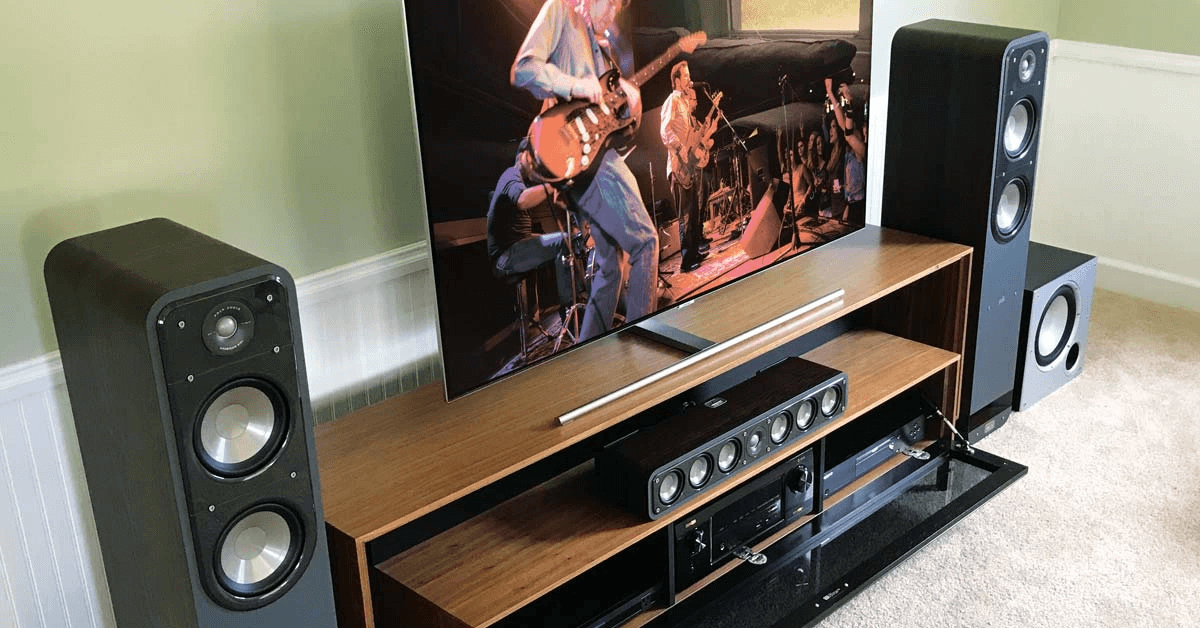Setting Up Home Theatre Acoustics
People try to find different ways to relieve themselves from the daily stresses of life. One of these stress relievers involves cuddling next to a loved one on a couch and watching a movie. A sound system can provide that desired getaway within the privacy of their own home. Some people may want to install a home theatre system for other reasons, such as to increase the value or look of their home. In either case, undertaking a home theatre project can induce a sense of agony over what gear to buy, where to install it, and understanding the targeted audience for proper theater room furniture placement. It’s difficult to enjoy the optimum audio performance without adequate home theatre acoustics. A custom theatre design with low-end speakers will have better sound quality than an untreated room with high-end speakers. Some experts assert that the speaker system and electronics layout only contributes to fifty per cent of the sound system’s overall volume. Neglecting to factor in acoustics in a home theatre might cause the sound system to sound only half as good as it could, and technically should according to manufacturing specifications.
Maximizing Acoustics

Every entertainment room should have the best possible acoustic treatment to obtain an ideal balance between direct and reflected sound for a perfect listening experience. Both ears hear direct sound emitting from the speakers, and reflected sound bouncing off the walls and other hard surfaces, such as coffee tables, chairs, cabinets, fireplaces, floors, and windows.
Direct sound provides the ears and brain with proper sound positioning that makes for easy listening. Reflected sound may contend with direct sound, which causes an imbalanced listening environment. Home theatre acoustics balance the direct to reflected sound ratio in accordance with the critical distance from the listening position. Achieving this perfect balance provides better clarity and articulation, especially through a multichannel sound system.
Sound Absorption

Room acoustics consist of introducing various theatre room furniture pieces that will perform different functions. For instance, absorption and diffusive materials regulate how much sound penetrates through the walls and ceilings.
A poly-cylindrical diffuser, a noise scattering material, appears as a half-raised hump protruding from the exterior wall and ceiling. Diffusers come in a variety of shapes and patterns. An estimated twenty per cent of the interior wall and ceiling surfaces are covered with 2-inch thick absorption materials. Acoustic experts recommend using Rockwool, a mineral made from volcanic rock, layered in the wall and ceiling. The other twenty to thirty per cent of the room should consist of scattering materials ranging between four to twelve inches deep. This level of thickness will diffuse audio waves of at least 500 hertz.
Speaker Position

Custom home theatre design installers should position absorbers near the estimated points of reflect off the left, right, and back interior walls. Homeowners can test for the first point of sound reflection by sliding a mirror along the room’s sidewall. The tester can sit at the main listening position to see whether he or she can catch a glimpse of the speaker through the mirror.
Home theatre acoustics should always have absorption and diffusive materials interspersed in vertical bands all around the room. In other words, if the installer places a diffuser on one side wall, then a second diffuser should sit in the corresponding location along the opposite wall. The ceiling requires at least one or two absorption panels at the first reflection point between the front speakers and the installation point.
Bass Traps
Bass traps help overcome low-frequency resonances. Customer home theatre design installers typically place bass traps in the room’s corners. Bass traps diminish the negative effects of resonance, whereby indistinguishable, uneven low frequencies accumulate from the three axes of the room’s corners.
The installers should place bass traps in the corners most affected by standing waves, usually found with a sound pressure level SPL meter. A standard room will typically require between one and two traps in the corners to increase clarity and provide even bass response.
Flooring
Home theatre acoustics flooring material provides an absorption and diffusive effect. Custom carpet for home theatre can introduce high-frequency absorption due to its relatively thin composition. Installers should focus on controlling mid-level frequencies, and simply allow the higher frequencies to provide a feeling of increasing spaciousness and air. Thick carpet with natural fibres and thick, fibrous material will provide the necessary absorption for the room’s flooring.
In addition, most acoustics home theatre experts recommend installing a sound absorption pit at the first reflection point in front of the speakers. A sound absorption pit provides excellent control over vertical reflections off the floor. It will also improve dialogue clarity and stereophonic imaging under the ideal conditions. Avoid installing too much sound absorption material in the room. A dead room with too much sound absorption sounds unnatural.
Home Theater Room

Most home theatre room acoustics experts recommend a dedicated room solely used for home theatre purposes. Installers can strategically place theatre room furniture to accomplish the needed room absorption and diffusion. Use heavy drapes with at least three inches of airspace for sound absorption purposes. Bookcases can create sound diffusion if the books are staggered and not correctly aligned. Decorative acoustic panels can cover the acoustical material for aesthetic sight. Installers should optimize subwoofer placement to deal with bass resonance issues.
Audio Analyzers
Custom home theatre design installers may recommend audio analyzers and other audio measuring tools. Some of this equipment can run into thousands of dollars. Since the advent of the iPhone, many companies have been offering more cost-effective home theatre acoustics solutions. The phone’s applications should offer basic modules, such as an SPL meter, a real-time analyzer, delay finder, wave generator, stereo oscilloscope, and a line-level tester. In addition, investing in acoustical tuning equipment can save money on unnecessary hardware upgrades.
Creating Sound Balance
In contrast to popular belief, home theatres are not fully optimized until installers have equipped the room with acoustical furnishings. The core principle behind sound acoustics is that the home theatre furnishings create an ideal balance of direct and reflective sound ratio. This maximizes the intensity of the sound for a clearer and more enjoyable experience from the listening point. Home acoustics can be applied to dual-space and dedicated rooms; however, each application may require different equipment for optimal output. In addition, home acoustics can be applied to small rooms, multichannel rooms, and recording studios.
Some home theatre acoustics projects can be installed by the homeowner if he or she has adequate mechanical and electrical experience; however, competent installers will ensure that the equipment functions in the way it was intended. Without home theatre acoustics, the sound emissions from a sound system would only be half satisfying, so look into it for a surreal experience!
Are you planning to build your own home theatre room? Contact us now! You can also schedule a virtual meeting with us to discuss your needs.
Call us 1300 498 268
Email us – enquires@acousticaprojects.com.au
Website – www.acousticaprojects.com.au

